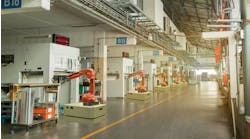The imagination age: Coming to a factory floor near you
There is nothing positive about a pandemic. Yet COVID-19, says Kevin Parikh, has become the equivalent of chief transformation officer for manufacturers, triggering the rapid adoption of digital manufacturing innovations that will spur organizations to be more creative and productive. “What the coronavirus did was flip a switch to the point that you can’t survive now unless you internalize these things,” says Parikh, chairman and CEO of global management-consulting firm Avasant.
Parikh, also an author, is a whiz at recognizing fast-moving workforce trends. His insights are designed to give business leaders and factory managers a clearer understanding of where the world is going, and how to get there before the competition.
The business and social transformations Parikh sees herald a new digital age when humans finally tame technology and unleash its full potential. Factory managers and workers should take note now. “The analog jobs that are getting replaced by digital automation and innovation are actually creating more time for us to be together,” he says. “It gives us a platform for new innovations, with unlimited data access and an opportunity to have unlimited time to create.”
Here are four top takeaways from MxD’s conversation with Parikh:
1. Congrats for surviving the Information Age—Parikh stresses the importance of business leaders, entrepreneurs, engineers, and others gaining breathing and thinking space in order to create. He says the early 21st century, which we spent utterly beholden to nascent digital technology, could go down as one of the worst periods in human history. Email, smart phones, desktops, laptops and PowerPoints robbed us of time, focus and relationships. “The Information Age is all about information overload,” he says. “Human beings lost connected touch with each other.”
But don’t worry, it’s temporary. The coronavirus was a wake-up call. So was that recent one-day Facebook outage, which encouraged humans to look up from their screens. Given temporary respite from the office grind, a lot of people recognized new, more independent ways to work. Millions of Americans left their jobs because of the pandemic, and economists believe many won’t return soon, if ever, to traditional employment. The Great Resignation is a real phenomenon. “People don’t want to do it anymore. They want off the treadmill,” Parikh says. “That free time will breed a desire to do something new. God knows what, but I believe in humanity. We’re going to innovate.”
2. Get ready for the Imagination Age—Parikh places us in a new post-Information Age period he calls the Digital Singularity, “when omnipresent technology and humanity combine.” Consider: The Internet of Things is happening. Video conferencing is embraced. Digital watches don’t just tell time, they monitor health. This current digital era sets up society for the next great transformation to what Parikh calls the Imagination Age, when technology both advances and recedes into the background, allowing it to serve its purpose of making work life more efficient in order to spur creativity. For example: picture a team of executives videoconferencing—while seated in a moving Tesla.
“Less focus on the machines, less focus on the processes, less focus on the hardware, but more focus on the ideas,” Parikh explained in a June speech. “Today’s companies are looking for ideas and data, and that’s the currency of tomorrow. Any investment level required to get there is what our clients are willing to make.”
Imagine, Parikh says, going into a smart room. Biosensors recognize the occupant, turn on screens and access all relevant data and files to make working easier. “The room becomes your room,” Parikh says. “That experience is where the workplace is going in the future.”
3. How about digital job sharing?—The prerequisites for manufacturing innovation in the digital age include the cloud, artificial intelligence, advanced sensors, and IT and OT cybersecurity. Implement those breakthroughs in a connected 5G world and, Parikh says, the economic impacts are profound: traditional communities and borders dissolve, replaced by trans-boundary communities of like interests. People can care more about, say, a singing group in China or India than anything in their own neighborhood. “This is a key tenet to how businesses need to work differently,” he says. “We have to appreciate that these communities exist, and to consider them as organizations that need to be marketed to or interacted with. These are micro-communities we can sell cars to, etc.”
Digital and social change can impact the way employees interact with employers: workers have greater leverage to negotiate terms of employment. A popular term coming out of COVID is “job crafting,” in which employees rewrite their own job descriptions to increase satisfaction and productivity. “Extensive research suggests that when employees have the flexibility to customize their work, they’re more effective, more satisfied and more likely to stay,” The Wall Street Journal reported.
Parikh flips that paradigm on its head and says companies can also job-craft. He cites a form of the sharing economy or crowdsourcing in which employees split their professional time between several companies. HyperloopTT, a company building advanced trains, started with no traditional employees, Parikh says. Forbes said Hyperloop’s early days combined facets of the gig economy with distance collaboration and crowdsourcing. It recruited engineers to moonlight in exchange for stock.
4. Lab groups for all—Parikh makes the case that automation and other advancements are not as scary for the future of individual workers as they might appear. He doesn’t worry much about robots destroying jobs. He puts a lot of faith in the ability of workers to adapt and innovate. The drop in the labor participation rate is more evidence that people are ready to make their own decisions about where to work. “Human beings are incredibly adaptable,” he says.
But there’s work for company leadership to do. “They’ve got to be investing in people who are willing to imagine and dream their new products, and communicate and market” to the billions of people now available online. Smart employees need to think both in terms of global markets and micro-markets.
To get there, more companies, Parikh says, should follow the lead of Google and develop their own internal laboratories of innovation. “Even in our firm we have a lab group called Avasant Labs. They’re innovators. They take the data and information we have and what’s in the marketplace and they come up with new products and services.”
The lab approach is vital to future success. “When you bring that into the culture of an organization, it is inspiring,” Parikh says. “It gets people thinking differently. Now the metrics are not how many widgets I turn, but how many new ideas do I come up with? How many new products?”
He says creative thinking helps identify surprising levels of interconnectedness, which spurs product development. “Today we have everything at our fingertips to design or build or manufacture anything we want,” Parikh notes. “But the one thing that we’re missing is the dreaming of what we could (have). The hardware, the machines, we don’t need people to run it. What we really need and don’t have enough of are creative-minded people.”
By Michael Lev for MxD



